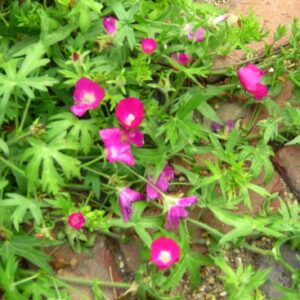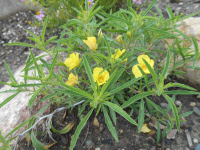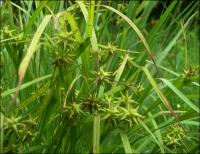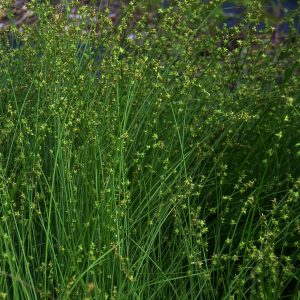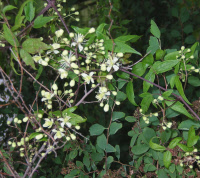Prairie Plants
Showing 17–24 of 81 results
-
Bouteloua curtipendula Sideoats grama Z 4-8
Narrow, blue-green leaves tinged purple or red in fall when golden oat-like seeds hang down one side of each leaf, eye-catching.
Narrow, blue-green leaves tinged purple or red in fall when golden oat-like seeds hang down one side of each leaf, eye-catching.
Size: 2-3' x 1'
Care: Sun in well-drained to moist well-drained soil, drought tolerant
Native: most of US, incl. Wisconsin
Wildlife Value: nesting material for butterflies and bees; larval host for some Skipper butterflies,
Awards: state grass of TexasKiowa natives who had killed an enemy in battle with a lance wore this. Collected and described by French planthunter André Michaux (1786-1802) who scoured Eastern North America west to the Mississippi over 11 years.
-
Bouteloua gracilis Blue grama Z 4-9
One sided, horizontal, purple tinged spikelets looking like a row of eyelashes above the petite clump of thin grass blades, July-October
One sided, horizontal, purple tinged spikelets looking like a row of eyelashes above the petite clump of thin grass blades, July-October
Size: 2' x 12"
Care: sun in dry to moist well-drained soil
Native: all US except SE & NW, Wisconsin native
Wildlife Value: Host for caterpillars of several skipper butterflies. Deer resistant
Awards: Great Plants for Great Plains Grass of the Year 2008For the Navajo this was a “life medicine” and an antidote to an overdose of “life medicine.” Also used to cure sore throats and cuts – chew on the root and blow on the cut. Navajo girls carried it in the Squaw Dance. Hopi made baskets from this grass. Zuni made brooms & hairbrushes from it. Several tribes ate this & made bedding for their animals from this. Lakota children played a game using this grass: Most of the stems have two flowers on them. Children competed to see who could find the stems with three flowers, like finding a four-leaf clover. First collected for horticulture by Humboldt & Bonpland who scoured Latin America from 1799-1804.
-
Callirhoe involucrata Wine cups, Prairie poppy mallow Z 3-9
Magenta-purple up-facing cups with white centers, June - October
Magenta-purple up-facing cups with white centers, June – October
Size: 6" x 12-24"
Care: Full sun in well-drained soil.
Native: Missouri to Texas
Wildlife Value: host for larva of Gray Hairstreak butterfly and nectar source for many different butterflies.
Awards: Missouri Botanic Garden Plant of Merit; 1999 Plant Select®; Great Plants for Great Plains Plant of the Year 2020Callirhoe is named for the goddess Callirhoe, daughter of Hermocrates, the Greek river god. Teton Dakota fired the dried root for smoke to cure the common cold and its aches and pains. The liquid used to boil the root relieved internal pain. First collected and named by English plant hunter Thomas Nuttall (1785-1859) but then renamed by other botanists. Ferry’s 1876 catalog described it as having “a trailing habit, of great beauty.” William Robinson (1838-1935), father of today’s mixed perennial border, recognized it to be “excellent for the rock garden, bearing a continuous crop of showy blossoms from early summer till late in autumn.”
-
Calylophus serrulatus Yellow sundrops, Shrubby evening primrose Z 4-9
Lemon yellow silky petals bloom late spring to early fall on this tough-as-nails native
OUT OF STOCK
Lemon yellow silky petals bloom late spring to early fall on this tough-as-nails native
Size: 9-18” x 12-15”
Care: sun in well-drained soil, drought tolerant
Native: Great Plains: Central Canada to TX, Michigan to Montana, WI native1st described in 1818 by Thomas Nuttall, English planthunter who collected hundreds of “new” plants in North America. Caly is Greek for calyx; lophos for “the back of the neck; crest of a hill or helmet” serrulatus means “minutely serrate” or “saw-toothed” describing the leaf margins.
-
Campanula rotundifolia Harebell, Bluebell of Scotland Z 3-8
Its delicate appearance conceals its hardy constitution. Dainty bluish-lilac bells to 12” stems on bushy round ground-hugging foliage. Blooms from June to October and occasionally November. Perfect for rock gardens and borders.
OUT OF STOCK
Its delicate appearance conceals its hardy constitution. Dainty bluish-lilac bells to 12” stems on bushy round ground-hugging foliage. Blooms from June to October and occasionally November. Perfect for rock gardens and borders.
Size: 9-12" x 12"
Care: Sun to part shade in moist well-drained soil
Native: Europe, Siberia and North America, including Wisconsin
Wildlife Value: Walnut and deer tolerantLakota ate the leaves raw and cooked and made an infusion of the roots to remedy earaches. Sir Walter Scott immortalized the Bluebell of Scotland in Lady of the Lake. Also a subject of Emily Dickinson’s poetry.
-
Carex grayi Gray’s Sedge Z 3-8
Cool club-like maces at the ends of stems- June to October
Cool club-like maces at the ends of stems- June to October
Size: 30" x 24"
Care: Full sun to part shade in moist or moist well-drained soil
Native: Vermont west to Wisconsin, south to Georgia and Missouri
Awards: Great Plants for Great Plains1st described in Vol VII of Transactions of Linnaean Society c. 1798. Botanists named and renamed it finally settling on Carex grayi to honor botanist Asa Gray (1810-1888).
-
Carex rosea Rosy sedge, Stellate sedge PERENNIAL GRASS Z 3-9
Mounds of thinnest of medium green leaves mingled with stems with star shaped seed clusters in May-June
OUT OF STOCK
Mounds of thinnest of medium green leaves mingled with stems with star shaped seed clusters in May-June.
Size: 12” x 10”
Care: part shade and shade in moist well-drained soil
Wildlife Value: No. Dakota south to TX & east incl. WI, New Brunswick and Nova Scotia.
Awards: Great Plants for the Great Plains Grass of the Year 2020Collected before 1811.
-
Clematis virginiana Virgin’s bower, Devil’s darning needles Z 4-8
July-September star-like white blossoms
July-September star-like white blossoms cover this vine – good for clambering up small trees.
Size: 12-20’ x 4’
Care: Sun to shade moist well-drained soil. Flowers on new stems so cut back in late winter or early spring to 6-8” above the ground.
Native: Nova Scotia to Georgia and as far west as Kansas, Wisconsin nativeThe genus Clematis was named by Dioscordes, physician in Nero’s army, from “klema” meaning climbing plant. One of 1st No. American plants sent to Europe – grew in Tradescant the Elder’s South Lambeth nursery in 1634. Grown by Jefferson at Monticello in 1807. Described by Breck in his 1851 book The Flower Garden: “The flowers are white borne upon cymes, and make a handsome appearance.” Cherokee mixed this plant with milkweed to remedy backaches. A root extract cured stomach aches, nervous conditions and kidney ailments. For the Iroquois powdered root fixed venereal disease sores and an extract of the stem brought on strange dreams. Pressed specimen in Emily Dickinson’s herbarium.



